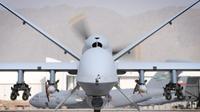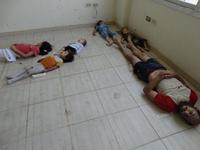-
Red Team’s concepts, approach gain support
Headed by Thom Mason, director of Oak Ridge National Laboratory (ORNL), Red Team aims to modernize the uranium processing procedure on a budget of $4.2 billion to $6.5 billion. Even before Red Teamdelivered its report on alternatives to the expensive Uranium Processing Facility (UPF) at the Y-12 nuclear weapons plant by the 15 April 2014 deadline, the group of experts, who come from different disciplines, had already gained support among energy officials and some members of Congress.
-
-
Improving the aerodynamic design of B61-12 bomb
Sandia National Laboratories has finished eight days of testing a full-scale mock unit representing the aerodynamic characteristics of the B61-12 gravity bomb in a wind tunnel. The tests on the mock-up were done to establish the configuration that will deliver the necessary spin motion of the bomb during freefall and are an important milestone in the Life Extension Program to deliver a new version of the aging system, the B61-12.
-
-
Silent-capable hybrid-electric military motorcycle
Fairfax, Virginia-based Logos Technologies has received a small business innovation research (SBIR) grant from DARPA to develop a military-use hybrid-electric motorcycle with near-silent capability. The company says that when fully matured, the technology will allow small, dispersed military teams to move long distances quickly and stealthily across harsh enemy terrain.
-
-
Tiny particles could help verify goods

Chemical engineers hope smartphone-readable microparticles could crack down on counterfeiting. Some 2 to 5 percent of all international trade involves counterfeit goods, according to a 2013 United Nations report. These illicit products — which include electronics, automotive and aircraft parts, pharmaceuticals, and food — can pose safety risks and cost governments and private companies hundreds of billions of dollars annually. Researchers have invented a new type of tiny, smartphone-readable particle that they believe could be deployed to help authenticate currency, electronic parts, and luxury goods, among other products. The particles, which are invisible to the naked eye, contain colored stripes of nanocrystals that glow brightly when lit up with near-infrared light.
-
-
West Point wins Cyber Defense Exercise, launches Army Cyber Institute
The U.S. Military Academy at West Point has won the annual Cyber Defense Exercise (CDX) which brought together senior cadets from the five service academies for a 4-day battle to test their cybersecurity skills against the National Security Agency’s (NSA) top information assurance professionals. West Point’s win comes just as the academy announced plans for its Army Cyber Institute(ACI), intended to develop elite cyber troops for the Pentagon.
-
-
U.S. Navy's laser weapon ready for summer deployment
Navy engineers are making final adjustments to a laser weapon prototype which will be the first of its kind to deploy aboard a ship late this summer. The prototype, an improved version of the Laser Weapon System (LaWS), will be installed on USS Ponce for at-sea testing in the Persian Gulf. Navy leaders have made directed-energy weapons a top priority to counter what they call asymmetric threats, including unmanned and light aircraft and small attack boats that could be used to deny U.S. forces access to certain areas. High-energy lasers offer an affordable and safe way to target these threats at the speed of light with extreme precision and an unlimited magazine.
-
-
Hacked U.S. surveillance drone over Crimea shows new face of warfare

A recent report of a U.S. surveillance drone flying over the Crimea region of Ukraine being hacked by Russian forces, is just one of many indication that the twenty-first-century global battlefield will take place in cyberspace. Radio and other frequencies which cover the electromagnetic spectrum are the new contested domain.
-
-
2014 edition of updated first responder biodetection technology guide available
A 2014 update to a detailed product guide listing biodetection technologies and sampling products is now available. The updated digest, Biodetection Technologies for First Responders: 2014, provides a comprehensive compilation of commercially available detection devices and products published to help first responders when purchasing equipment and supplies needed to rapidly assess biological threats.
-
-
New York will issue red license plates for government emergency response vehicles
Governor Andrew Cuomo last week announced that the Department of Motor Vehicles will begin issuing the first New York State emergency management red license plates for vehicles registered to state agencies and political subdivisions such as counties, cities, towns, and villages. Vehicles that serve a critical role will be given the new emergency license plates to assure they have immediate access to locations impacted during a state emergency as well as prioritized access for assets such as emergency fuel supplies.
-
-
Lt. Gen. Frank Klotz (Ret) confirmed as DoE undersecretary for nuclear security, NNSA administrator
Lieutenant General Frank G. Klotz, United States Air Force (Ret.), was confirmed by the Senate on Tuesday, 8 April 2014, as the Department of Energy’s undersecretary for nuclear security and administrator for the National Nuclear Security Administration (NNSA).
-
-
UAV-mounted high-speed wireless networks for remotely deployed troops
Missions in remote, forward operating locations often suffer from a lack of connectivity to tactical operation centers and access to valuable intelligence, surveillance, and reconnaissance (ISR) data. The assets needed for long-range, high-bandwidth communications capabilities are often unavailable to lower echelons due to theater-wide mission priorities. DARPA’s Mobile Hotspots program makes progress toward the goal of providing 1 Gb/s communications backbone to deployed units.
-
-
Israel: Assad used chemical weapons on 27 March in a Damascus neighborhood

President Bashar Assad’s military used chemical weapons two weeks ago in a neighborhood east of Damascus against opposition forces, a senior Israeli defense official said yesterday (Monday). Syrian rebels reported of two instances in which Assad’s forces used chemical weapons recently, both about two weeks ago and both in Damascus neighborhoods, and the Israeli confirmation was the first information provided by outside intelligence sources to back up the rebels’ claims.
-
-
Spectrum Challenge: more robust, resilient, reliable radio communications
Reliable wireless communications today requires careful allocation of specific portions of the electromagnetic spectrum to individual radio networks. While pre-allocating spectrum is effective in benign environments, radios remain vulnerable to inadvertent interference from other emitters and intentional jamming by adversaries. On 19-20 March 2014, fifteen teams from around the country demonstrated new ways to help overcome these challenges by participating in the final event of the DARPA Spectrum Challenge — a national competition to develop advanced radio techniques capable of communicating in congested and contested electromagnetic environments without direct coordination or spectrum preplanning.
-
-
New consortium dedicated to developing nuclear arms control verification technologies
A consortium of thirteen universities and eight national laboratories, led by the University of Michigan and including the Los Alamos National Laboratory as a partner, has been awarded a $25 million grant by the NNSA. The consortium is dedicated to the research and development (R&D) of nuclear arms control verification technologies, including nuclear safeguards effectiveness.
-
-
Cutting edge, animatronic mannequin to test CB protective suits, equipment
The U.K. Defense Science and Technology Laboratory (DSTL) has taken delivery of a new robotic mannequin which will be used to test chemical and biological (CB) protective suits and equipment for the U.K.’s Armed Forces. The “Porton Man” uses state of the art technology and is able to walk, march, run, sit, kneel and even lift its arms as if to sight a weapon just like an infantry soldier.
-
More headlines
The long view
Why Was Pacific Northwest Home to So Many Serial Killers?
Ted Bundy, Gary Ridgway, George Russell, Israel Keyes, and Robert Lee Yates were serial killers who grew up in the Pacific Northwest in the shadow of smelters which spewed plumes of lead, arsenic, and cadmium into the air. As a young man, Charles Manson spent ten years at a nearby prison, where lead has seeped into the soil. The idea of a correlation between early exposure to lead and higher crime rates is not new. Fraser doesn’t explicitly support the lead-crime hypothesis, but in a nimble, haunting narrative, she argues that the connections between an unfettered pollution and violent crime warrant scrutiny.
Bookshelf: Smartphones Shape War in Hyperconnected World
The smartphone is helping to shape the conduct and representation of contemporary war. A new book argues that as an operative device, the smartphone is now “being used as a central weapon of war.”
